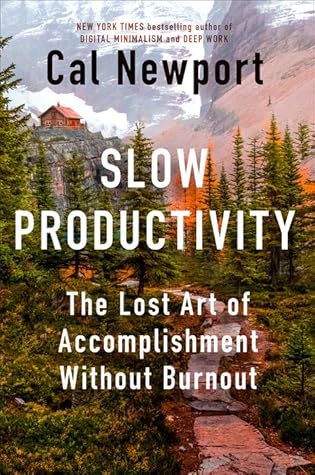More on this book
Community
Kindle Notes & Highlights
by
Cal Newport
Read between
December 10 - December 28, 2024
None of these answers included specific goals to meet, or performance measures that could differentiate between doing a job well versus badly.
for all of our complaining about the term, knowledge workers have no agreed-upon definition of what “productivity” even means.
It was from this uncertainty that a simple alternative emerged: using visible activity as a crude proxy for actual productivity.
As the twentieth century progressed, this visible-activity heuristic became the dominant way we began thinking about productivity in knowledge work.
we also gravitate away from deeper efforts toward shallower, more concrete tasks that can be more easily checked off a to-do list.
The use of visible activity as the primary means of approximating actual productive effort.
This sudden interest in workplace experimentation is both welcome and needed, as much about how we work in the knowledge sector today is ossified into tradition and conventions, some of which are arbitrary and some of which are borrowed from different, older types of work.
KNOWLEDGE WORK (GENERAL DEFINITION) The economic activity in which knowledge is transformed into an artifact with market value through the application of cognitive effort.
SLOW PRODUCTIVITY A philosophy for organizing knowledge work efforts in a sustainable and meaningful manner, based on the following three principles: 1. Do fewer things. 2. Work at a natural pace. 3. Obsess over quality.
Slow productivity supports legacy-building accomplishments but allows them to unfold at a more human speed.
PRINCIPLE #1: DO FEWER THINGS Strive to reduce your obligations to the point where you can easily imagine accomplishing them with time to spare. Leverage this reduced load to more fully embrace and advance the small number of projects that matter most.
Whether your task list is overflowing or sparse, you’re still working more or less the same number of hours each week. The size of your list affects only how usefully these hours produce results.
In knowledge work, by contrast, pushing employees into larger workloads can decrease both the quantity and quality of what they produce.
The reality is that saying no isn’t so bad if you have hard evidence that it’s the only reasonable answer.
Small tasks, in sufficient quantity, can act like productivity termites, destabilizing the whole foundation of what you’re trying to build.
Containing tasks is not about escaping the small. It’s instead about making these efforts as painless as possible. Seeking, as I once put it, that “low-stress sweet spot.”
What was provided instead were upgraded Zoom accounts and cheerful email exhortations to “stay productive.” It was crazy-making.
Relief, in other words, trumps expediency.
You should give your efforts the breathing room and respect required to make them part of a life well lived, not an obstacle to it.
A key tenet of slow productivity is that grand achievement is built on the steady accumulation of modest results over time. This path is long. Pace yourself.
Slowing down isn’t about protesting work. It’s instead about finding a better way to do it.
Depending on the details of your role, this probably won’t mean spending weeks staring up at tree branches or typing notes on a typewriter, but it will almost certainly lead to a more sustainable relationship with your job.[*]
This is what ultimately matters: where you end up, not the speed at which you get there, or the number of people you impress with your jittery busyness along the way.


